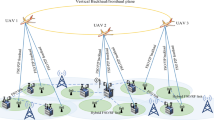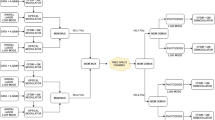Abstract
Free space optical (FSO) communication is a wireless alternative to fiber-based communication as it may provide a backbone emergency communication link in disaster-hit areas. This paper proposes a full duplex millimeter wave (mm-wave) enabled FSO system to provide a high data rate communication link for search and rescue operations. The proposed system consists of a central unit which is connected to multiple unmanned aerial vehicles (UAVs) through an optical-amplify and forward relay over an FSO channel represented by Log-Normal channel model. An optical comb is generated and Laguerre-Gaussian modes of each wavelength of the optical comb are exploited to carry 10 Gbps differential phase shift keying modulated signals. 60 GHz mm-wave signals are generated at the remote UAVs by employing optical heterodyne detection for downlink transmission towards the user equipment. For the uplink transmission, a dedicated wavelength is used to carry 10 Gbps on-off keying baseband data for live streaming of the disaster-hit area. Furthermore, a single hop scheme is employed to counter the non-line of sight issue of the FSO link. The performance of the proposed model is evaluated under different weather conditions and refractive index structure parameter values. A maximum distance of 3.3 km is achieved for clear sky under low turbulence conditions. Moreover, the effect of misalignment due to hovering of the UAVs on the system performance is also investigated and tolerance in the x (horizontal) and y (vertical) directions is observed at the forward error correction BER limit of \(10^{-9}\). The simulation results reveal that the proposed system has the potential to provide reliable and quick emergency communication services in disaster-struck areas.








Similar content being viewed by others
Data Availability
The datasets generated during and/or analyzed during the current study are available from the corresponding author upon reasonable request.
References
Jahid, A., Alsharif, M. H., & Hall, T. J. (2022). A contemporary survey on free space optical communication: Potentials, technical challenges, recent advances and research direction. Journal of Network and Computer Applications, 200, 103311.
Alawad, W., Halima, N. B., & Aziz, L. (2023). An unmanned aerial vehicle (UAV) system for disaster and crisis management in smart cities. Electronics, 12(4), 1051.
Shah, D., & Kothari, D. (2014).“Optimization of 2.5 Gbps WDM-FSO link range under different rain conditions in Ahmedabad," In 2014 Annual IEEE India Conference (INDICON), Pune, India, (pp. 1–4)
Robinson, S., Jasmine, S., & Pavithra, R. (2015). Investigation on hybrid WDM (DWDM+CWDM) free space optical communication system. ICTACT Journal on Communication Technology, 6(12), 1187–1192.
Prabu, K., Charanya, S., Jain, M., & Guha, D. (2017). BER analysis of SS-WDM based FSO system for Vellore weather conditions. Optics Communications, 403, 73–80.
Huang, X. H., Li, C. Y., Lu, H. H., Su, C. W., Wu, Y. R., Wang, Z. H., & Chen, Y. N. (2018). WDM free-space optical communication system of high-speed hybrid signals. IEEE Photonics Journal, 10(6), 1–7.
Umezawa, T., et al. (2019). 25-Gbaud 4-WDM Free-Space Optical Communication Using High-Speed 2-D Photodetector Array. Journal of Lightwave Technology, 37(2), 612–618.
Yaseen, M. A., Abass, A. K., & Abdulsatar, S. M. (2021). Improving of wavelength division multiplexing based on free space optical communication via power comparative system. Wireless Personal Communications, 119, 381–391.
Fadil, E. A., Abass, A. K., & Tahhan, S. R. (2022). Secure WDM-free space optical communication system based optical chaotic. Optical and Quantum Electronics, 54, 477.
Trichili, A., Park, K.-H., Zghal, M., Ooi, B. S., & Alouini, M.-S. (2019). Communicating using spatial mode multiplexing: Potentials, challenges, and perspectives. IEEE Communications Surveys & Tutorials, 21(4), 3175–3203.
Jeyaseelan, J., Sriram Kumar, D., & Caroline, B. E. (2020). Disaster management using free space optical communication system. Photonic Network Communications, 39, 1–14.
Sarangal, H., Singh, A., Malhotra, J., et al. (2017). A cost effective 100 Gbps hybrid MDM-OCDMA-FSO transmission system under atmospheric turbulences. Optical and Quantum Electronics, 49, 184.
Singh, M., & Malhotra, J. (2019). 2 x 10 Gbit/s-10 GHz radio over free space optics transmission system incorporating mode division multiplexing of Hermite Gaussian modes. Journal of Optical Communications, 45, 2546. https://doi.org/10.1515/joc-2019-0047
Singh, M., & Malhotra, J. (2019). Long-Reach High-Capacity hybrid MDM-OFDM-FSO transmission link under the effect of atmospheric turbulence. Wireless Personal Communications, 107, 1549–1571.
Grover, A., Sheetal, A., & Dhasarathan, V. (2020). Performance analysis of mode division multiplexing based free space optics system incorporating on-off keying and polarization shift keying under dynamic environmental conditions. Wireless Networks, 26, 3439–3449.
Singh, M., Atieh, A., Aly, M. H., Somia, A., & El-Mottaleb, A. (2022). 120 Gbps SAC-OCDMA-OAM-based FSO transmission system: Performance evaluation under different weather conditions. Alexandria Engineering Journal, 61(12), 10407–10418.
Jeyaseelan, J., Sriram Kumar, D., & Caroline, B. E. (2020). Disaster management using free space optical communication system. Photonic Network Communications, 39(1), 1–14.
Amphawan, A., Arsad, N., Neo, T. K., Jasser, M. B., & Mohd Ramly, A. (2022). Post-Flood UAV-based free space optics recovery communications with spatial mode diversity. Electronics, 11(14), 2257.
Wu, D., Sun, X., & Ansari, N. (2022). An FSO-based drone assisted mobile access network for emergency communications. IEEE Transactions on Network Science and Engineering, 7(3), 1597–1606.
Hu, B., Wang, L., Chen, S., Cui, J., & Chen, L. (2022). An uplink throughput optimization scheme for UAV-enabled urban emergency communications. IEEE Internet of Things Journal, 9(6), 4291–4302.
Optiwave“Optiwave Photonic Software, [online] Available: https://optiwave.com/,".
Iqbal, S., Raza, A., Fasih Uddin Butt, M., Ghafoor, S., & El-Hajjar, M. (2020). A full-duplex radio over fiber architecture employing 12 Gbps 16 \(\times\) 16 optical multiple input multiple output for next-generation communication networks,". Transactions on Emerging Telecommunications Technologies, 31(8), e3910.
Mirza, J., Ghafoor, S., & Hussain, A. (2019). All-optical generation and transmission of multiple ultrawideband signals over free space optical link. Optical Engineering, 58(5), 056103.
Davaslıoğlu, K., Çağıral, E., & Koca, M. (2010). Free space optical ultra-wideband communications over atmospheric turbulence channels. Optics Express, 18(16), 16618–16627.
Raza, A., Ghafoor, S., & Butt, M. F. U. (2017). MIMO-enabled integrated MGDM-WDM distributed antenna system architecture based on plastic optical fibers for millimeter-wave communication. Photonic Network Communications, 35, 265–273.
Mehmood, T., Qayyum, H., & Ghafoor, S. (2019). Polarizationmultiplexing based duplex radio-over-fiber link for millimeterwave signal transmission to a ring of multiple radio access units. Frontiers of Information Technology Electronic Engineering, 20, 300–306.
Funding
No funding was received for this work.
Author information
Authors and Affiliations
Contributions
All authors contributed equally to this work.
Corresponding author
Ethics declarations
Conflict of interest
The authors declare no conflict of interest or competing interests.
Additional information
Publisher's Note
Springer Nature remains neutral with regard to jurisdictional claims in published maps and institutional affiliations.
Rights and permissions
Springer Nature or its licensor (e.g. a society or other partner) holds exclusive rights to this article under a publishing agreement with the author(s) or other rightsholder(s); author self-archiving of the accepted manuscript version of this article is solely governed by the terms of such publishing agreement and applicable law.
About this article
Cite this article
Iqbal, S., Raza, A., Kaleem, M. et al. A full duplex LG modes enabled millimeter-wave based FSO communication system for disaster zone. Wireless Netw 30, 961–971 (2024). https://doi.org/10.1007/s11276-023-03526-y
Accepted:
Published:
Issue Date:
DOI: https://doi.org/10.1007/s11276-023-03526-y




